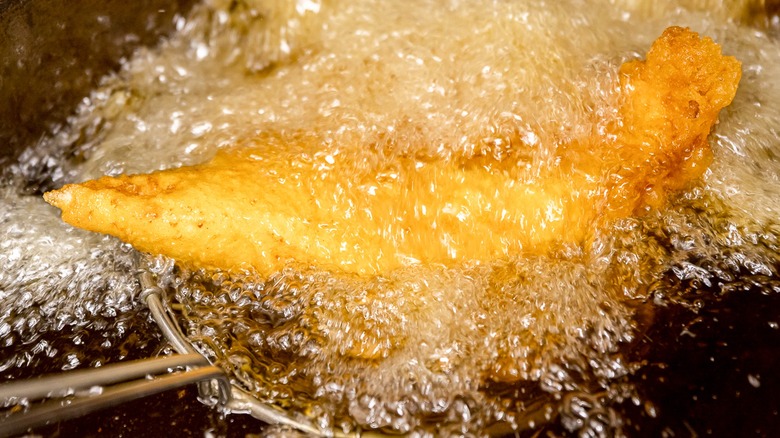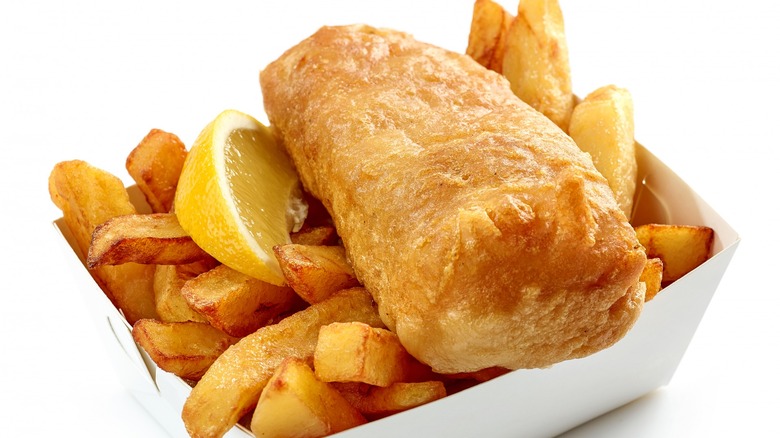Why Your Fish And Chips Ended Up Soggy
Fried to crisp, golden perfection, fish and chips are mouthwateringly divine. This is why it's so devastating when your best-laid plans end with a plate of doughy wet mush (insert crying emoji). To ensure this travesty never happens to you again, you'll need to parse out the culprits behind your failed attempt to learn why your much beloved British fare turned out as soggy as England's Lake District in autumn. Armed with this newfound knowledge, you will be able to go forth once again to slay the oil-soaked-dish, but now with the certainty of a crisp, yet fluffy, battered conquest in your sights.
Though at first glance, fish and chips don't appear to be complicated to make — some fresh halibut, cod, haddock, salmon, or any other fish that holds up to frying, a little dip in some batter, peeled and cut potatoes, and a pan of piping hot oil — no brainer, right? But there are a few factors that can cause everything to go awry. It all starts with the trinity of sins: overly wet ingredients, the wrong oil temperature, and an overcrowded pan.
For perfect fish and chips, cook them dry
The first mistake you'll want to avoid when frying up classic British fish and chips is forgetting to properly dry your potatoes and fish before frying. If your ingredients start out waterlogged, you'll never have a chance at that perfectly crunchy beer-battered flavor and those oh-so-crispy-on-the-outside-potatoey-on-the-inside fries to accompany it.
For crispier chips, double fry 'em (once before frying your fish and once after). But first, you'll need to thoroughly sop up all the excess moisture, patting your fries dry with paper towels prior to frying. And while some people parboil their taters in anticipation of quicker frying, it's still just as important that they enter the hot oil as dry as possible. If you prefer to do this, lay the potatoes out on a cooling rack or paper towels to air dry post-parboil but before frying.
You'll also want to pat down your fish fillets with a paper towel before coating them with a light dusting of flour and then dipping them into your wet batter. Remember, excess moisture is your enemy when it comes to fried food. Keeping things as dry as possible also helps prevent grease from splattering out of the pan and causing a burn or starting a fire.
Temperature is the key to crispy fish and chips
The wrong temperature can wreak havoc on your fish fry, so don't start frying until the oil has reached between 325 and 375 degrees Fahrenheit. If your oil's not hot enough, the fish will take longer to cook throughout and may soak up a lot of excess oil, rendering your coating soggy. Conversely, if the oil is too hot you'll risk smoking oil, burning batter (goodbye golden hue, hello darkness my old friend), and potentially undercooked fish at its core. To ensure the correct temp, keep a deep-frying thermometer on hand, eliminating guesswork.
Also, avoid overcrowding your pan; doing so can cause your oil's temperature to drop, leading again to uneven cooking and oil-logged sogginess. Instead, it's best to fry in batches, transferring fried foods to cooling racks with paper towel-lined baking trays beneath them to drain any excess grease.
One last note, if you like to shake on malt vinegar, squeeze on lemon, or pile on the tartar sauce to your fried fish before tucking in, use caution, for all your anti-sog efforts could be felled in one swoop. In all cases, it's best to shake, squeeze, and dip as you eat, so you don't mush up your crisp fish with too much moisture. And there you have it, three tips to keep your chips crisp and your fish far from soggy — dry it, fry it (at the right temp), and don't crowd it. Bob's your uncle.


